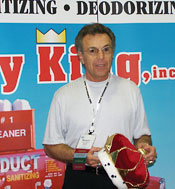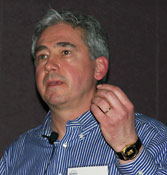
Robert Baker of BBJ Environmental Solutions and Thomas Yacobellis of Buster Enterprises Inc. let it be known that each has an effect on the livelihood of every NADCA member.
"ACR 2005 - Assessment, Cleaning and Restoration 2005" is NADCA's latest standard. It defines acceptable cleanliness levels after duct cleaning. The standard provides two methods of verifying cleaning effectiveness and specifies general requirements related to occupant health and safety, equipment, and other areas of cleaning.
S-520, from the Institute of Inspection, Cleaning, and Restoration Certification (IICRC), is a standard and reference guide for professional mold remediation.
S-180, being put together by the American Society of Heating, Refrigerating, and Air-Conditioning Engineers (ASHRAE), is attempting to establish minimum HVAC inspection and maintenance requirements designed to preserve a system's ability to achieve acceptable thermal comfort, energy efficiency, and indoor air quality (IAQ).
"They really should be coordinated with each other, unless we want the world really, really confused," advised Baker, who also is president of the Indoor Air Quality Association (IAQA).
NADCA's standard is revised as needed. S-520 is currently being updated by IICRC, with a scheduled release early next year. S-180, on the other hand, is 10 years in the making, with a possible public review by the end of this year. "For ASHRAE, 10 years is a millisecond in regard to getting a standard finalized," said Baker.

New At NADCA, ASHRAE
Baker walked through some of the primary issues concerning each standard:"Those who have been in the business have become sensitized to mold," said Baker. "Whether mold can be harmful, there has been a lot of anecdotal material to date. Over the past five years, we have heightened our sensitivity towards mold."
While the entire content of the standard has not been nailed down, Baker did highlight some of the proposed guidance provided in it. In regard to air handlers, for instance, the standard notes that coils become soiled within a year of being placed in service. A soiled air-handling unit contributes to poor IAQ; in addition, equipment life is cut short, energy efficiency decreases, cooling capacity is hampered, and airflow is restricted.
Even with excellent filtration, coils will soil, noted Baker. The proposed standard is suggesting to clean coils and drain pans. Baker added that one should also include both blowers and motors.
Baker said he believed the new ASHRAE standard will be discussed at the association's meeting this summer, with a possible public review before the 2006 Winter Meeting in Chicago.
Because most Americans are not familiar with the microbial world, which is described in detail in the IICRC standard, Yacobellis tried to link visuals to the terms. He compared one millimeter to the thickness of a dime on its side; he said a micron is one-tenth the thickness of a dime. Because mold is described as being 2 to 5 microns in size, he wanted attendees to realize what they are dealing with and how to explain this to consumers.
According to Yacobellis, the human nose can only inhale particles up to 10 microns. "If pollen were a basketball, mold would be a ping-pong ball in comparison," he said. "Our nose filters most pollens, but molds can easily bypass our nasal filter system. As a result, you must understand the difference and present this to a consumer."
Billions of mold spores can be released after poor duct cleaning, which is one reason why IICRC put together its standard for mold remediation.
"So, can we do this [duct cleaning] for $89?" Yacobellis asked. "Hell, no. This is why we want to separate ourselves from the rest. We need to follow these standards in order to provide clean ducts."

Sidebar: Differentiate To Get More Business
LAS VEGAS - Being a member of the National Air Duct Cleaners Association (NADCA) is definitely a step in the right direction. However, in the eyes of David Gordon of Indoor Air Professionals Inc., being a member doesn't necessarily mean you will be different from everyone else."You have to market yourselves as more than just duct cleaners," he told his audience of NADCA members at the association's recent meeting. "Differentiation is a key in winning negotiated work."
According to Gordon, the pressure from occupants and senior management is to answer these questions:
1. How can we improve energy efficiency?
2. How safe is the air we're breathing in this building?
3. What are we doing to reduce liability associated with mold and sick buildings?
Up until now, answers to these questions were drawn based on activity and/or a checklist. Today, however, answers are being founded in data from the delivered performance of the HVAC system, Gordon said. Therefore, he recommended that members supply the "programmatic"-based approach in resolving issues.
That means having an enhanced HVAC system cleaning project that "helps verify that other variables which affect building performance and overall IAQ are in compliance. The net result is to reduce costs and create a positive indoor environment."
Gordon said the next generation of HVAC cleaning and IAQ services should focus on more comprehensive programs. He said the programmatic approach provides knowledge and fact-based feedback to improve HVAC system performance. Moreover, HVAC systems are now prime targets to achieve lower operating costs.
Gordon maintained that HVAC system cleaning, combined with constant equipment monitoring, will provide that promised enhanced program.
It's "a powerful sales tool," he said. "Building optimization and a cost-saving story gets you in the door."
In the end, he said a contractor can win new HVAC cleaning contracts by differentiating - meaning, selling more comprehensive IAQ programs. With this in place, a contractor can justify a project with potential energy savings. "Move your relationship from a vendor to a partner," Gordon concluded.
- Mark Skaer
Publication date: 05/02/2005

Report Abusive Comment